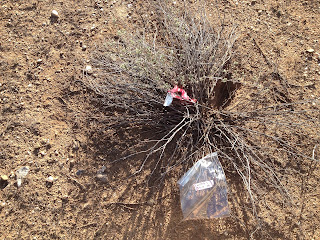Climate has been changing on this planet, and will continue to change. We hear a lot about warmer temperatures, but that's just one piece of the story. Another important part of climate is also changing, and that's precipitation.
Here in the Sonoran Desert, we get rain during two different seasons: during winter and during our summer monsoons. With climate change, we are seeing our precipitation change. One prediction for the future of the southwestern U.S. is that we will get rain less frequently, but when it does rain, the storms will be larger. How will less frequent precipitation influence the ecosystem? Even though the rain that comes may deliver more rain at once, a lot of that extra rain can't be absorbed into the soil. So that might mean less water available overall for the organisms.
Certainly the plants will respond to that change. If they can't rely on receiving water as frequently as they're used to, it's harder for some plants to survive. A lot of studies have looked into plant responses to changing precipitation patterns. In our research group, we like to learn about the soil community that support the plants: the microbes and invertebrates that recycle nutrients so that the rest of the ecosystem can thrive! How will they respond to changes in precipitation? Much less is known about that!
 |
| Soil invertebrates include organisms like this velvet mite. |
So we did an experiment to find out! In the Sonoran Desert, we spent one monsoon season changing the timing and size of rainfall and measured how the soil community responded. We used watering cans to make "fake" rainfall events.

We watered the soil using either the normal pattern for precipitation during monsoon season (as our control treatment) or with changes to the frequency and size of the storm. Some of our plots received rain at the same size of storm but less frequently. Other plots received rain at the same frequency but with larger amounts of rain. Then other plots received rain in what is predicted for the future: less frequently but with larger amounts.
We then took soil samples and extracted the soil invertebrates so that we could see how they changed in response to the experimental rain. We predicted that the communities would become less abundant and diverse if they received rain less frequently. But we had another question: Do plants help protect the invertebrate community from changes in rainfall? Plants provide shelter for the soil beneath them, providing shade, pulling water towards the surface of the soil, and creating food for the soil organisms. If plants are present, does that mean the invertebrates don't feel the impact of precipitation as much?
So we did our experimental rainfall experiment in soils directly beneath plants and compared that to the rainfall experiment on bare soil, Here, Kelly is "making it rain" beneath a creosote bush.
We also wanted to know whether type of plant matters. Creosote bush is a larger shrub that has deep roots and keeps its leaves all year round. We also did the experiment under a different type of shrub. Bursage is a smaller shrub that goes dormant during periods of drought. They drop their leaves, stop photosynthesizing (so stop bringing up water). That means that a bursage in spring might look like this:
But during periods of drought (like a hot, dry summer!) might look like this:
That creates a very different habitat for soil organisms than a big, evergreen creosote bush! So we "made it rain" with either less frequent or larger rainfall events (or both!) under creosotes, bursage, and bare soil over the course of one monsoon season.
We collected soil at the start of the experiment to look at initial differences between creosotes, bursage, and bare soil. Then we collected soil again at the end of the experiment to see how soil communities responded to the change in precipitation. We predicted that we would see more change in the bare soils compared to soils beneath plants, because we expected the plants to help protect the invertebrates from the lack of water we created.
In the lab, we extracted the soil invertebrates from the soils. Then, we used microscopes to look at the invertebrates, so that we could identify and count them. A LOT of students helped us with the microscope work!
From the results, we learned that plants have a big influence on the soil invertebrates. The community of invertebrates living beneath creosote and bursage plants is much bigger and more diverse. The invertebrates must really like having the shade and resources from a plant above them! Both creosotes and bursage housed larger communities, but creosotes had the strongest effect. The invertebrates really like the shade and resources from deeper rooted plants that are active during monsoon season!
Changing precipitation didn't have a big influence over how many invertebrates lived in the soil, but it did change the diversity of the invertebrates. There are many different ways to count "diversity", and two of these measures were influenced by changing rainfall (Shannon diversity index and evenness). Making rain fall less frequently reduced the diversity of invertebrates in the soil. However, as we predicted, the communities beneath plants were less effected than in the bare soil. Soil invertebrates living away from plants are exposed to the changes in precipitation, but they are more protected when they have the help of a plant. That means that if the abundance of plants like creosote and bursage change in response to the climate, the soil invertebrate community will change. And those invertebrates do a lot of important processes for nutrient recycling and decomposition in soil, so there can be major consequences for the overall ecosystem!
The results of this study are published in: Ball, B.A., K. Bergin, A. Morrison. 2023. Vegetation influences desert soil arthropods and their response to altered precipitation. Journal of Arid Environments 208: 104873. DOI:10.1016/j.jaridenv.2022.104873








No comments:
Post a Comment